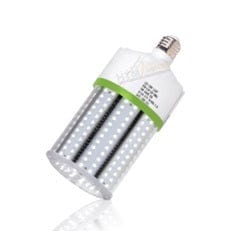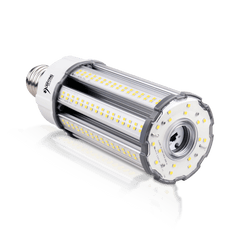Looking For LED Corn Lights? Don’t Forget To Consider These Factors
LED corn lights, also called LED Corn Cobs, are widely recognized in the commercial and industrial lighting industry due to their ability to save significant amounts of energy, while enabling customers to keep their current fixtures by simply retrofitting them with a quick ballast bypass. Some common applications to install these commercial bulbs, would be inside parking lot light fixtures, highbay, and post top lamp fixtures among others.
their ability to save significant amounts of energy, while enabling customers to keep their current fixtures by simply retrofitting them with a quick ballast bypass. Some common applications to install these commercial bulbs, would be inside parking lot light fixtures, highbay, and post top lamp fixtures among others.
The bulb itself is made up of multiple tiny LED SMD Chips, all protectected by a IP64 dustproof plastic cover which makes it perfect for outdoor applications like lighting up parking spots, security perimeters, as well as retail environments.
While switching from metal halide to LED corn lights is a great affordable idea, you should be aware of a few decision factor to make sure you will pick the right equivalent for your new lighting:
The Correlated Color Temperature (CCT)
The color temperature basically refers to the warmth of the light being emitted from a light bulb. It is one of the important characteristics as it helps determining the mood of the space you wish to light. The apparent color of LED lights is measured in Kelvin. The higher it is, the whiter the light would be. When browsing through LED corn lights, you will find a number of color temperatures to choose from, but the most popular and recommended one would be 5700K (Daylight White).
![]() Watts
Watts
The watts mentioned on the LED corn light will tell you the amount of energy it consumes. While LED corn lights consume over 75% less energy than their HID equivalent they will also last 3-5 times longer! For instance, to replace a 400W Metal Halide bulb, you would need a 120W LED Corn Light. For a 250W Metal Halide Bulb, we would typically recommend the 80W Model.
Lumens
While the watts help identify the amount of energy being consumed, the lumens help gauge the amount of light emitted from the bulb. The higher the lumens, the more light a corn light will produce. Most commercial customers consider the lumens instead of the watts while purchasing LED lights. You always want to look for the highest lumens per watt ratio, as lumens is what lights up the room, and the watts is what consumes the energy.
Installation Conditions
If you are planning to use LED corn lights in outdoor applications, they can be installed in fully-enclosed fixtures unlike other bulbs which may dim overtime as the case temperature will become too hot. After a simple ballast bypass, and re-wiring the main power to the E39 lamp holder, you can simply screw in your new corn light, as they have a multi-tap internal driver rated at 100-277V.
LED corn lights are rapidly gaining attention across the commercial lighting industry due to their exceptional brightness, performance, affordability, and simple installation. At HTM Lighting, we have a comprehensive collection of LED corn lights for our clients. Get in touch with us to discuss your needs.
- Hugo Merminod

 Watts
Watts




